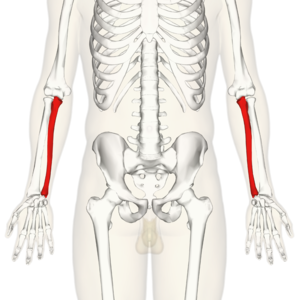Ulna
Original Editor
Top Contributors - Abbey Wright, Kim Jackson, Chrysolite Jyothi Kommu, Rishika Babburu and Joao Costa
Description[edit | edit source]
The ulna is one of two bones that make up the forearm, the other being the radius. It forms the elbow joint with the humerus and also articulates with the radius both proximally and distally. It is located in the medial forearm when the arm is in the anatomical position. It is the larger of the two forearm bones.[1]
Structure[edit | edit source]
The ulna is a long bone larger proximally than distally.
Proximal ulna[edit | edit source]
The proximal ulna is hook-like in form which articulates with the trochlea of the humerus to create the hinge joint of the elbow.[2]
The articulation is formed of the olecranon and the coronoid process.
Olecranon[edit | edit source]
This is a large, curved bony prominence which is accepted into the olecranon fossa, located on the humerus, during elbow extension.
The olecranon forms the upper part of the semi-lunar notch which is a smooth, large depression and articulates with the humeral trochlea during elbow flexion and extension.
Coronoid process[edit | edit source]
The coronoid process is a horizontal, bony projection which attaches directly onto the ulnar shaft. It is received into the coronoid fossa of the humerus in elbow flexion. The coronoid process also forms the lower part of the semi-lunar notch.
On the lateral side of the coronoid process is the radial notch where the head of the radius sits.
Function[edit | edit source]
Articulations[edit | edit source]
Muscle attachments[edit | edit source]
Triceps - attaches to the posterior of the olecranon process.[1]
Brachialis - attaches to anterior, inferior coronoid process
Clinical relevance[edit | edit source]
Assessment[edit | edit source]
Treatment[edit | edit source]
Resources[edit | edit source]
References[edit | edit source]
- ↑ 1.0 1.1 Gray HFRS, Gray's Anatomy 15th edition, New York, NY: Barnes & Noble,2010. p120-126
- ↑ Palastanga N, Soames R. Anatomy and Human Movement, structure and function 6th edition, London, UK: Churchill Livingstone Elsevier ,2011. p45
- ↑ Simply AandP. Ulna. Available from: https://www.youtube.com/watch?v=-1oOpLsyHUA [last accessed: 11/10/2013]








